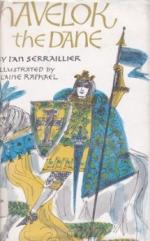Title: Havelok The Dane A Legend of Old Grimsby and Lincoln
Author: Charles Whistler
Release Date: July 7, 2004 [EBook #12847]
Language: English
Character set encoding: ASCII
*** Start of this project gutenberg EBOOK Havelok the Dane ***
Produced by Martin Robb.
Havelok the Dane: A Legend of Old Grimsby and Lincoln.
By Charles W. Whistler
Preface.
If any excuse is needed for recasting the ancient legend of Grim the fisher and his foster-son Havelok the Dane, it may be found in the fascination of the story itself, which made it one of the most popular legends in England from the time of the Norman conquest, at least, to that of Elizabeth. From the eleventh to the thirteenth centuries it seems to have been almost classic; and during that period two full metrical versions—–one in Norman-French and the other in English—– were written, besides many other short versions and abridgments, which still exist. These are given exhaustively by Professor Skeat in his edition of the English poem for the Early English Text Society, and it is needless to do more than refer to them here as the sources from which this story is gathered.
These versions differ most materially from one another in names and incidents, while yet preserving the main outlines of the whole history. It is evident that there has been a far more ancient, orally-preserved tradition, which has been the original of the freely-treated poems and concise prose statements of the legend which we have. And it seems possible, from among the many variations, and from under the disguise of the mediaeval forms in which it has been hidden, to piece together what this original may have been, at least with some probability.
We have one clue to the age of the legend of Havelok in the statement by the eleventh-century Norman poet that his tale comes from a British source, which at least gives a very early date for the happenings related; while another version tells us that the king of “Lindesie” was a Briton. Welsh names occur, accordingly, in several places; and it is more than likely that the old legend preserved a record of actual events in the early days of the Anglo-Saxon settlement in England, when there were yet marriages between conquerors and conquered, and the origins of Angle and Jute and Saxon were not yet forgotten in the pedigrees of the many petty kings.
One of the most curious proofs of the actual British origin of the legend is in the statement that the death of Havelok’s father occurred as the result of a British invasion of Denmark for King Arthur, by a force under a leader with the distinctly Norse name of Hodulf. The claim for conquest of the north by Arthur is very old, and is repeated by Geoffrey of Monmouth, and may well have originated in the remembrance of some successful raid on the Danish coasts by the Norse settlers in the Gower district of Pembrokeshire, in company with a contingent of their Welsh neighbours.




